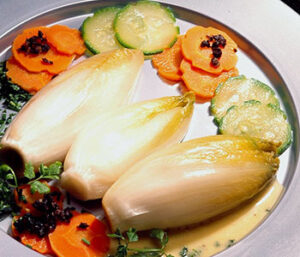 Endive is a member of the Asteraceae botanical family, which also includes artichoke, chicory, escarole, Jerusalem artichoke, lettuce, radicchio, romaine, safflower and sunflower. There are two distinct forms of the endive vegetable.
Endive is a member of the Asteraceae botanical family, which also includes artichoke, chicory, escarole, Jerusalem artichoke, lettuce, radicchio, romaine, safflower and sunflower. There are two distinct forms of the endive vegetable.
About Endive
- Endive, pronounced “en-dive,” is a leafy green lettuce grown outside in fields, similar to other lettuce varieties. The endive plants are harvested, packaged and sent to grocers directly from the field and eaten like lettuce greens.
About Belgian Endive
- Belgian endive, pronounced “un-deev,” requires a distinct two step growing process.
- First, chicory seeds are sown and grown in a field for around 150 days. The chicory seeds grow a deep taproot along with a leafy green plant on the surface.
- Once mature, the tops are cut off and the roots are dug up and placed in cold storage for a dormancy period.
- The roots are then removed from cold storage for a second growth of approximately 28 days in a dark, cool, humid room until fully developed and ready for sale.
- The Belgian endive plants contain two varieties, red and white.
- In the United States, Belgian endive is grown under the brand California Endive.
Nutrition Information
- Endive is an excellent source of vitamin K and vitamin A.
- Vitamin K is required from building bones and blood clotting.
- Vitamin A is involved in immune function, healthy vision and reproduction.
- Endive can be eaten raw or cooked. Add to salads or soups, roast, grill or sauté.
Nutrition Facts
1/2 cup, raw
Calories: 425 | Protein: 0.3 g | Fat: 0.05 g | Carbohydrate: 0.8 g | Fiber: 0.7 g | Calcium: 13 mg | Magnesium: 3.75 mg | Phosphorus: 7 mg | Iron: 0.2 mg | Folate: 35.5 mcg | Vitamin A: 542 IU
Recipes
Request an Appointment
